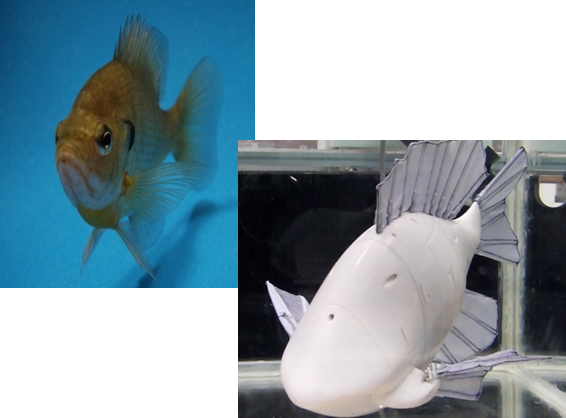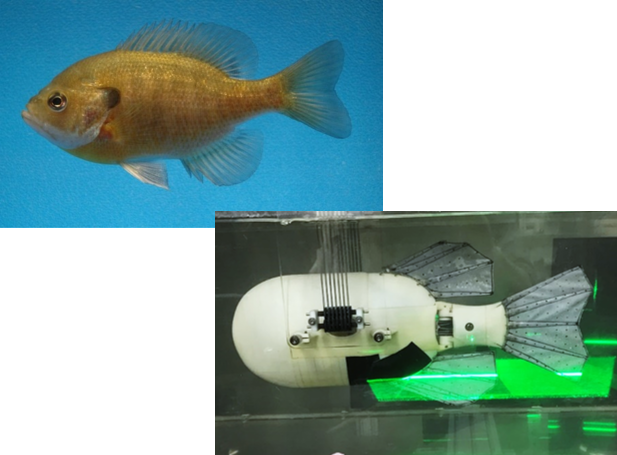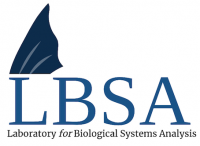Current Research
Neural control of sunfish
This work is being conducted by Gabe Carryon.
This research is attempting to answer the following biological and robotic questions: What is the underlying neural network structure of the sunfish, both anatomy and physiology? What is an appropriate computational model both for individual neurons, and neural networks, used for control? How do neural networks generate rhythmic patterns for movement (e.g. central pattern generators)? What sensory information is used for control, and how is it integrated into the neural architecture?
This work is conducted in collaboration with Dr. Melina Hale, in the Department of Organismal Biology and Anatomy, at the University of Chicago.
Biorobotic model for investigations of multi-fin swimming


This work is being conducted by Anthony Mignano, and has two primary objectives;
- Identify and understand the capabilities and biomechanical properties of fish’s body and fins that are necessary to effectively control swimming forces
- Implement the identified critical functions on a multi-fin swimming robot to achieve locomotory goals and facilitate future research.
The bluegill sunfish is representative of a large class of bony fish (Teleostei) that use multiple fins and a bending body to interact with and move through their aquatic environment. They are capable of coping with a wide variety of fluidic conditions, using relatively small groups of neural oscillator networks to control hundreds of body and fin muscles in a highly coordinated fashion that changes depending on their many swimming gaits. The sunfish also incorporates large amounts of sensory data from its visual, vestibular, lateral line and other sensory systems to modulate the fin and body movements. Understanding the interactions of these systems of fin kinematics, body dynamics, neuromuscular control and sensory systems is integral to understanding and replicating the sunfish’s swimming abilities.
Relevant characteristics of these different systems have been incorporated into the design of three generations of biorobotic models as platforms for continued research. Each biorobotic model was developed to focus on different aspects of swimming; paired pectoral fin motions and a body with tunable mass and buoyancy characteristics, kinematic and geometric relationships between the tail and median fins that impact forces, free-swimming platform with distributed and heterogenous sensors for controller development using machine learning. Each platform allows for interrogation and development of a fundamental understanding of the systems with a strong connection back to its biological counterpart. In the past, this kind of research has generated new questions for biological research. And as new knowledge of the biology enables the creation of better biorobotic models, this kind of collaborative research can facilitate breakthroughs in both fields.
This work is being conducted in collaboration with Professor George Lauder (Organismal and Evolutionary Biology, Harvard University).
CFD model for investigations of multi-fin swimming
High mean thrust forces observed when fins are flapped out of phase.
Low mean thrust forces observed when fins are flapped in phase.
This work is conducted by Shraman Kadapa.
Fish use coordinated motion of their fins and body to propel and maneuver. They are capable of dynamically changing their swimming gait for different locomotory tasks. The objective of this work is to understand how propulsive forces from a pair of interacting fins and its associated fin-wake interaction is affected by variations in kinematic, geometric and temporal relationships.
A 2D computational fluid dynamic(CFD) simulation is developed to visualize flow and estimate propulsive forces as the relative phase between the fins is altered. High mean thrust forces are observed when there is good alignment of the wake shed by upstream fin on the downstream fin. When the fins are flapped out of phase, the angle of attack(AOA) of the downstream fin with the wake shed by the upstream fin is relatively low throughout a fin beat leading to minimal flow separation. On the contrary, when fins are flapped in phase, the AOA of the downstream fin is high throughout majority of the fin beat which led to disruptions in flow.
Biomechanics of hydrodynamics of the flippers and body during maneuvers
This work is conducted by Nick Marcouiller.
Nick’s research is in understanding the locomotive techniques used by the California Sea Lion in and out of the water. To conduct his research, he has developed a robotic sea lion research platform. With this platform he can better understand the dynamic and kinematic principles used by the animal to execute maneuvers such as banked turns in the water and terrestrial movement.
Investigating swimming gait control for bio-robotic platforms using RL
This work is conducted by Andy Drago.
Andy’s research is in applying reinforcement learning and other machine learning techniques to control the motion of underwater fin and flipper based robotic platforms. Coordinating the control of multiple fins/flippers and body joints to produce efficient motion and maneuvers is exceedingly difficult and requires significant background knowledge and substantial fine tuning. Reinforcement learning is a tool that is gaining a lot of interest and has had a lot of success in helping to tune controllers for complex gaits in quadruped robots which exhibit many similar challenges for control presented by underwater swimming systems. Andy is focusing on adapting these learning techniques to improve the control of underwater swimming systems and to produce desired motions in a given swimming robot.
Analysis of infrastructure development initiatives on underserved communities
This work is conducted by Lauren Garofalo.
Lauren’s research focus involves studying the implications of current infrastructure development initiatives on community systems. The goal is to determine how infrastructure development can be modified to be more equitable and “people-centric”. She is currently studying varying data analysis technologies, such as machine learning, as well as the consequences of previous infrastructure development initiatives to better understand how to improve infrastructure in a manner that provides the most benefit to previously underserved communities.
Past Projects
- Develop bio-robotic model of sea lion pectoral flipper to study kinematics and forces
- System Identification of the Mechanical Properties and Hierarchical Control of a Swimming Fish
- Neuromechanics of Fish Sensorimotor Control
- Development of a Cervical Spine Protection Device
- Develop designs for wood turning lathes that can be made and sustained from materials available locally in East Africa and be powered by an energy source other than electricity from the grid
- Understand the effects of added mass on the dynamic motions of the head and trunk during natural activities such as walking and running
